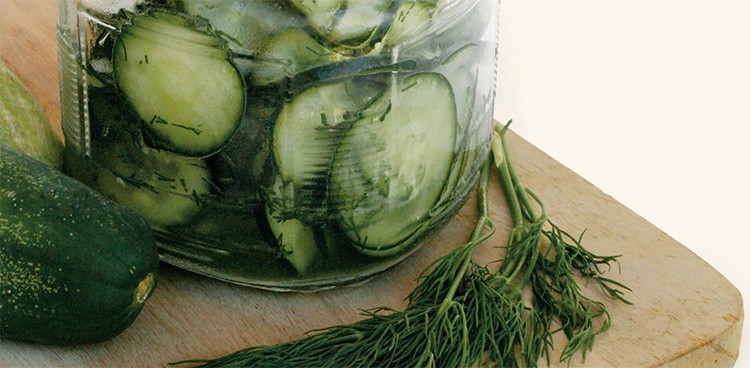Cucumbers, garlic, and lemons are ripe for pickling

When I was 2, my mother walked into the kitchen to find me elbow-deep in a nearly empty jar of pickled pepperoncini. She worried I would burn a hole in my stomach with all that spice, but my only concern, apparently, was finding every pepper in the jar. And so concluded my successful first date with pickles.
I like to think of “pickle” as more of a verb than a noun. Most fruits and vegetables, fresh and wonderful as they are in the raw, can be transformed into something far more delicious with the help of a little salt and vinegar. They last longer this way, plus their flavors deepen as they sit in the pantry or back of the fridge. Pickled sugar snap peas, red onion, asparagus, or blueberries: These are powerhouse ingredients that make everything tastier, including a cheese plate.
Below, find three of my favorite pickle recipes, each made with a different technique. The first, pickled garlic, is great for summer and early fall when bulbs are at their peak. Pickled in a classic vinegar brine and canned in a water bath, they’re shelf-stable and ready to gift year-round. The second is a quick-pickled cucumber salad that takes just moments of active time and ups the crunch, flavor, and lifespan of the veggies. And the third is a fermented pickle: preserved lemons. I make a big batch of these every year and use them in everything from chicken soup to hummus to cocktails. Each technique works well with other produce, too. Fair warning: Pickling is addictive, so don’t forget to leave room in your refrigerator for other items—such as your favorite wedges and wheels—for pairing.
Pickled Garlic
Ingredients
- 1 pound garlic heads cloves separated and peeled (about 5 heads)
- 1 tablespoon whole mustard seeds
- 1 tablespoon whole black peppercorns
- 1 ½ cups apple cider vinegar
- 2 tablespoons granulated sugar
- 2 teaspoons kosher salt
Instructions
- Pack garlic cloves into 5 sterilized ½-cup jars. Divide mustard seeds and peppercorns between the jars.
- In a small saucepan over high heat, combine vinegar, sugar, and salt. When mixture begins to boil, pour over jarred garlic. Top jars with lids and rings, gently tightening each ring just enough to close it.
- Process jars in a water-bath canner for 10 minutes. Let jars sit for a week before opening and use within 1 year.
Dilly Quick-Pickled Cucumbers
Ingredients
- 1 pound cucumbers sliced paper-thin with a knife or mandoline
- 1 ½ teaspoons kosher salt
- 2 tablespoons finely chopped fresh dill
- 1 ½ tablespoons rice vinegar
Instructions
- In a colander, combine cucumbers and salt. Gently massage salt into cucumbers. Let drain about 20 minutes.
- Taste a cucumber. It should be salty, but not mouth-puckering. If the veggies are too salty, give them a light rinse under cold water. Transfer salted cucumbers to a medium bowl and fold in dill and vinegar. Transfer to a lidded glass jar and place in the refrigerator to pickle at least another 30 minutes before eating. Pickles will keep in the refrigerator up to 5 days.
Preserved Lemons
Ingredients
- 3 pounds organic lemons 10 to 14 lemons
- 1 cup kosher salt
- 2 cups lemon juice plus more for filling jars
- 1 to 2 tablespoons bay leaves cardamom pods, dried chilies, cinnamon sticks, or other whole herbs or spices (optional)
Instructions
- Scrub lemons. Cut 1 end off each lemon. Hold a lemon cut side up and slice lengthwise down the center, stopping before the knife cuts all the way through the fruit. Rotate lemon a quarter-turn and slice again lengthwise down the center, stopping before the knife cuts all the way through the fruit. Repeat with remaining lemons. (Lemons will be quartered, but still attached at 1 end.)
- Pour salt into a medium bowl. Working in batches, add cut lemons, a few at a time, and rub the flesh of each lemon with salt. Add a few tablespoons of salt from the bowl to the bottom of a sterilized ½-gallon glass jar. Push the first few lemons against the bottom of the jar. They will release juice. Add a few tablespoons of salt from the bowl to the jar, along with a sprinkle of herbs and spices, if using. Salt a few more lemons in the bowl and transfer to the jar, repeating the process until the jar is full. You want to use all the salt in the bowl, so be generous as you layer the lemons and dump any leftover salt from the bowl into the jar at the end.
- Press lemons down with a wooden spoon to release more juice. Pour additional lemon juice into the jar to fill all space around the lemons. Cover jar with a sterilized lid and shake well.
- Let lemons ferment at room temperature, giving the jar a gentle shake or turn every day or so. Lemons will be ready to eat in 3 weeks, at which point you can transfer jar to the refrigerator where they’ll keep for up to 1 year.
Feature Photo Credit: Andrea Duarte




